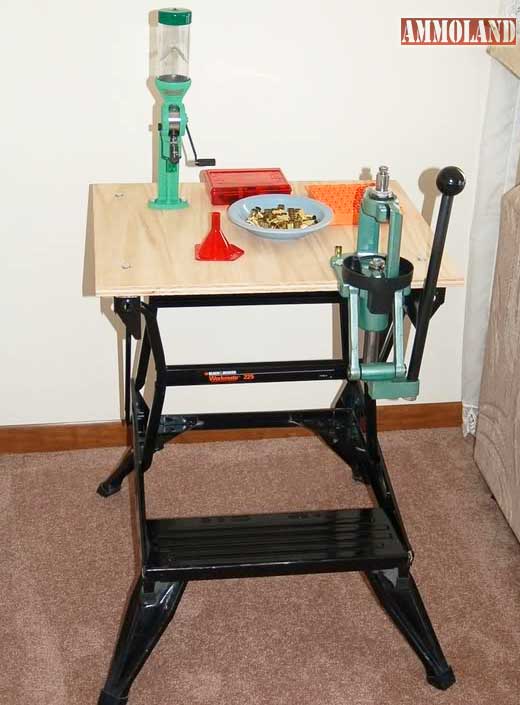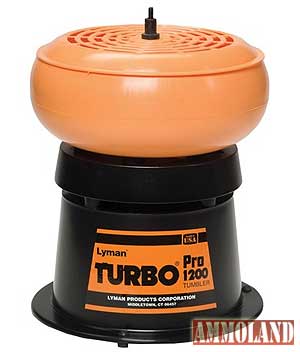By Roy Hill, Brownells Copywriter

Des Moines, Iowa – -(Ammoland.com)- I remember what it was like to be a rookie reloader.
In a lot of ways, it’s like being a rookie shooter, or maybe driving a car for the very first time. The first time I sat down at my bench to prime and charge cases, I had the same tight feeling in my chest, the same heightened awareness of every move I made, as I did the first time my grandfather showed me how to operate a shotgun or the first time I got behind the wheel of my family’s Matador station wagon when I was only 15.
I was very concerned about doing everything exactly right, and I was very excited to see if I could actually make my own ammunition that would work in my gun. I was so anxious to test my first batch of .38 Special reloads, that I grabbed the first six cartridges I produced along with a revolver and some ear muffs and almost jogged out to my backyard pistol range. Six loud, satisfying bangs later, I ejected the empties, and then quickly went back inside so I could reload them again.
Just like acquiring any other skill that involves potentially dangerous machinery – like operating a chainsaw – reloading requires attention to detail, the right equipment, and concentration. And learning that you can do it well brings the same satisfaction and sense of accomplishment. Of course, you’ll hear other reasons for getting into reloading: it saves you money, you can make super-accurate ammo tailored to your specific gun, you can make ammo in hard-to-find calibers or even in calibers that are no longer commercially manufactured at all.
All of them are 100 percent true. But the main reason I reload is the kick I get from shooting ammo that I made, myself.
If you shoot much at all, you’ve probably already got some spent brass laying around. You’ll need the correct powder, primers, and bullets for the caliber you want to reload – plus some basic reloading tools.
Education, Education, Education
Reloading is one of those activities that really must be done by the book. A good load manual published by a reliable source is a must for every reloader. Most people who reload wind up owning several load manuals. Do NOT trust load data published on an Internet site or forum unless you consult a quality load manual first. And if you’re ever in doubt about a specific load, just follow what a good manual says. One of the terms you’ll come across on the Internet that’s sometimes connected to load recipes not published in reputable manuals is “KABOOM.” To avoid getting acquainted with Mr.“KABOOM” on a very personal level, follow a manual, every single time.
Get good manuals and study them, often.

Reloading Press – Single Stage or Progressive?
Lots of folks will say that rookie reloaders should start with single-stage presses. I’m one of the odd-ducks who ran out and got one of the big expensive progressive presses to start with. I’ve reloaded with both single-stage and progressives, and think that both types have their good points and limitations.
First off, a single-stage press is just what it sounds like: a press with a single stage. Every step of the reloading process, from removing the spent primer and resizing the cartridge case, to repriming and charging with powder, to seating and crimping the bullet properly, is done on the same single stage.
You just have to change dies for every step. Typically, folks do the steps in batches. Deprime and resize 50 cases. Then swap dies and prime and charge 50 cases, swap dies and seat 50 bullets, and so on.
A progressive press does several reloading steps simultaneously. It takes longer to set up a progressive press, but once it is, you can really crank out the reloads quickly, since the press will simultaneously perform several reloading steps on several cartridge cases – so long as you remember to rotate the cartridge cases to the next step!
If you don’t pay attention while operating a progressive press, it’s easy to make a mistake like not putting any powder into the cases.
Do your research. Think about what types of ammo you specifically intend to reload, for what purposes, and how comfortable you are with machines, following directions, and staying focused on one task. For example, if you plan to reload 20 to 50 rifle cartridges a few times a year for hunting and sighting-in, a simple, single-stage press would be perfectly fine.
However, if you want to reload hundreds of pistol rounds a week so you can economically practice for 3-gun or action pistol matches, a progressive press might be a better choice.

Again, choosing what kind of press you need is a very personal choice, and one that you need to think about and research.
The purpose of the press, of course, is to hold the cartridge cases to be reloaded and the reloading dies…
Do Or Dies
New reloaders can be stunned by the sheer variety of dies available. There are dies that push out spent primers and reshape only the neck of a rifle cartridge case. There are dies that resize the entire length of the case. There are dies that slightly bell the mouth of a case and fill it with powder.
There are dies that seat bullets and dies that crimp cases mouths around those bullets. There are dies to form and trim one type of cartridge case into a completely different cartridge case. There are almost endless variations of all these types of dies, with several choices for each caliber, and sometimes in calibers you’ve never even heard of.
If you are a rookie reloader, don’t get caught up in all the types of dies. Stay narrow and focused. Choose one specific caliber to reload at first and get a die set from a reputable maker to start with. Learn that set of dies first, and only after you’ve reloaded with it for a while and start to really understand it, then branch out into other types of dies if you want. But start simple at first.
Think of it as similar to learning the rifle shooting fundamentals of proper position, breath control, trigger control, and follow through before you start worrying about wind formulas, mil-dot ranging formulas, or spindrift. Crawl first; then walk.
All That Other Stuff
Of course, there is a lot of other stuff you’ll need. To keep from getting overwhelmed with choices, rookie reloaders should focus on one specific caliber, and get only the accessories for that one caliber. Depending on the type and brand of press you bought, you will need a shell plate or shell holder to hold cases in the press. Typically, single-stage presses use shellholders, while progressive presses use shell plates. The instructions that come with your press will tell you how to identify the shellholder or ’plate you need.
You must also have some way of accurately measuring powder. Some die sets come with pre-calibrated scoops that tell you how much of which type of powder to use. There are powder hoppers that mount directly onto your bench, or mount onto progressive presses and can be adjusted to throw different sized powder charges. There are even more expensive automatic powder measuring systems available. Again, think carefully about your specific goals and needs when deciding on how to measure powder. Do you want to carefully handcraft a few rounds of highly-accurate ammo for a specific rifle? Or crank out mass quantities of practice or plinking ammo?

A reloading scale of some sort is a must. Reloading scales are available in traditional balance beam or electronic models and are calibrated in grains, the standard unit of measure used in the United States for reloading. The scale will help you set powder charges, weigh bullets, and verify that your powder measure is consistently throwing the correct-weight charge. You will also need a precision measuring tool accurate to within .001″, like a standard dial or electronic caliper. Especially if you are reloading for a semi-automatic, your rounds need to be kept to the correct overall length to ensure proper feeding from the magazine. If you plan on reloading rifle cartridges, you absolutely need a case trimmer. Lots of handgun cartridges can be reloaded without trimming, but most rifle cartridges produce pressures high enough to make the brass “flow” when fired, increasing the length of the case. If you really get into reloading, you will eventually have to buy a case trimmer anyway, along with a tool to deburr trimmed cases so bullets seat smoothly.
Optional, But Nice To Have
Most people like to clean off their brass before they reload, and a case cleaner is a good purchase. There are vibratory case cleaners, tumblers, even sonic cleaners that use liquid solutions and high-frequency sound waves to get all the grit and grime off cartridge cases. Think about which method of cleaning cases works for you. How much room do you have in your reloading area? What part of the house is it in? Some of these cleaners can be quite loud when they’re operating.
And while you don’t have to purchase one, a chronograph is the best way to find out how well your reloads are performing. A chronograph helps you measure bullet velocities to determine how consistent your reloads are; the more consistent and repeatable, the more it helps accuracy. Especially if you want to work up a load customized for your specific firearm, a chronograph is a very good purchase.
As with golf, duck hunting, homebrewing, or any hobby you get into seriously, you may eventually wind up accumulating quite a bit of reloading equipment. But you don’t need it all at once to get started successfully. Choose one caliber to begin with, and then at the bare minimum, buy a press, set of dies, the correct shell plate or shell holder, powder measuring tools, a reloading scale, and calipers. If you’re reloading rifle cartridges, add a case trimmer and associated tools. If you plan on getting serious about reloading, invest in a case cleaner and a chronograph. And above all else, find some good, quality reloading manuals and read them, read them, read them. Did I mention reading the manual? The manual keeps you from meeting Mr. KABOOM.
Once you do finally get your reloading gear set up, you too can experience the thrill and satisfaction of shooting targets with ammo that you made, all by yourself.
About Brownells
Founded in 1939, Brownells is an Iowa-based, family-owned company that supplies more than 75,000 firearms parts, accessories, reloading components, gunsmithing tools, and ammunition to armorers, gunsmiths, and shooters worldwide. In addition to their industry leading 100% lifetime guarantee on EVERY product sold, their staff of veteran Gun Techs are available to assist customers with any need – free of charge. There are no minimum order sizes or fees. To place an order, or for more information, call 800-741-0015 or or visit Brownells.com

